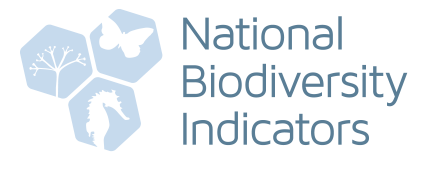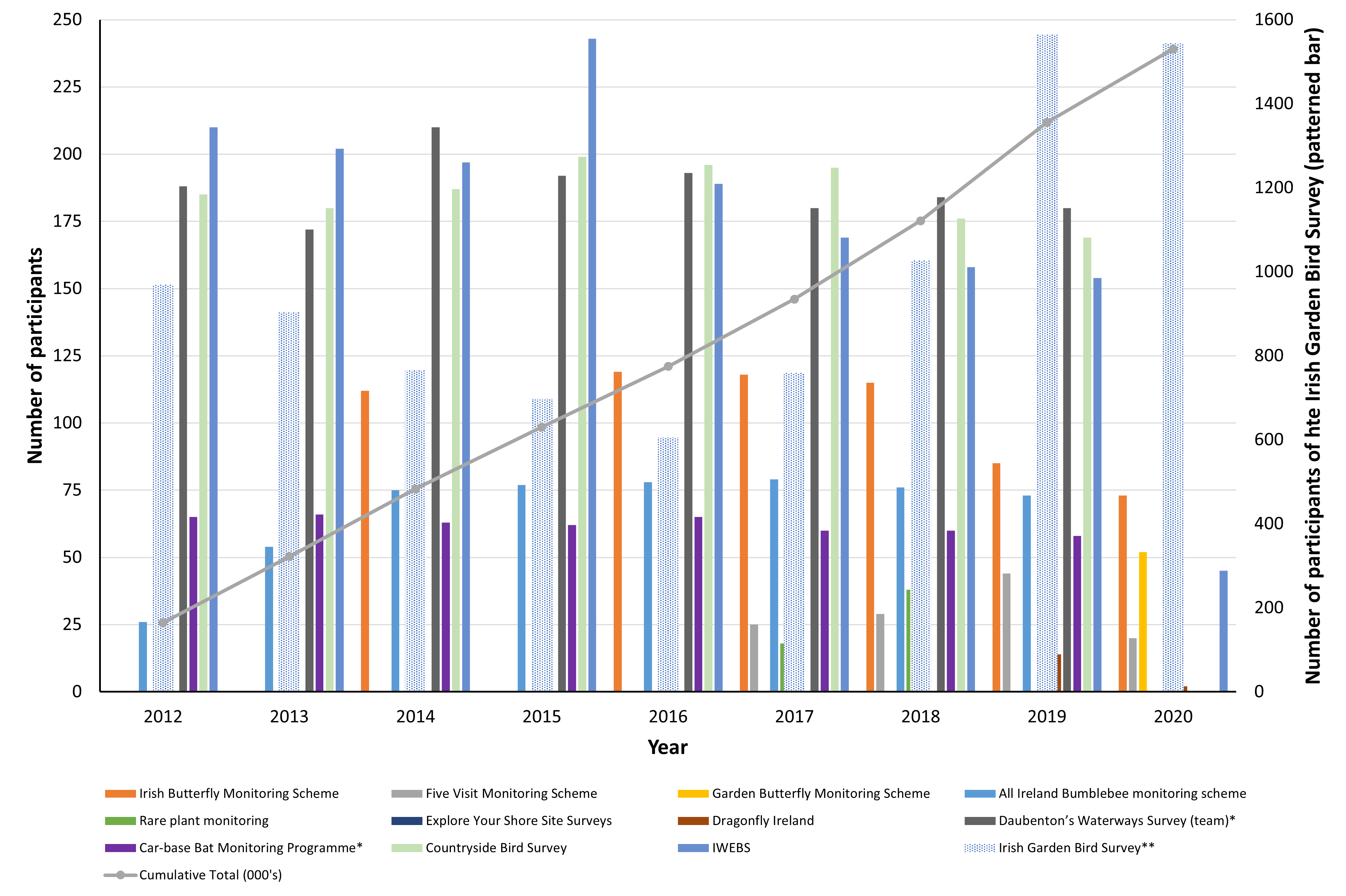| Current status | 2022 |  |
| Short term status | 2018 - 2022 |  |
| Long term status | 2012 - 2022 |  |
Click on the charts below in order to see the full resolution versions.
Monitoring biodiversity is an essential way of evaluating the integrity of ecosystems and the species within them, their response to disturbances such as habitat loss, pollution and climate change, and the success of actions taken to conserve or recover biodiversity. If monitoring biodiversity was restricted to professional ecologists then data would be limited by their distribution and scarcity, and the availability of funding to employ them. Alternatively, engaging with non-professionals (i.e, volunteers) can contribute to the success of long-term and large-scale monitoring through their commitment, enthusiasm, and geographic spread. As well as this, some of Ireland’s species reporting obligations to the European Commission are aided by citizen scientist involvement. Indeed, considering volunteers in participatory monitoring is an example of ‘citizen science’ which is increasingly being recognized as a credible tool for scientific research and monitoring.
The monitoring schemes included in this indicator are those which are completed on a regular basis and where participants follow a structured protocol while collecting data. The data is then compiled in a central database and used to make inferences about the species. The monitoring schemes included are:
Butterflies
Irish Butterfly Monitoring Scheme: A fixed route is walked once a week from April to September and the number and species of butterflies are recorded. This scheme provides information both on butterfly population change and phenological (timing of life cycle events) change.
Five Visit Monitoring Scheme: This is identical to the Irish Butterfly Monitoring Scheme but requires less time. The aim is to walk twice between the April and June, and three times between July and August.
Garden Butterfly Monitoring Scheme: The Garden Butterfly Monitoring Scheme is done in your garden and only takes 15 minutes. If you can record in the same location over multiple times it will make your data more valuable as this allows us to see changes over time.
All butterfly schemes are coordinated by the National Biodiversity Data Centre and more information can be found here: https://biodiversityireland.ie/monitoring/
Bees
All Ireland Bumblebee monitoring scheme: A fixed route (1-2km) is walked once a month between March and October. The number and species of bees are recorded and the data feeds into the national population trends of bumblebees.
The All Ireland Bumblebee monitoring scheme is coordinated by the National Biodiversity Data Centre and more information can be found here: https://biodiversityireland.ie/surveys/bumblebee-monitoring-scheme/
Plants
Rare plant monitoring: Recorders who had submitted recent casual records of rare plants to the National Biodiversity Data Centre were asked if they would be willing to visit their rare plant population once a year during its flowering period and to count the total number of individuals present. Data on the rare plant location, the count and additional information about the site is submitted online to the Data Centre.
Rare plant monitoring is coordinated by the National Biodiversity Data Centre and more information can be found here: https://biodiversityireland.ie/surveys/rare-plant-monitoring/
Marine
Explore Your Shore! Site Surveys: Explore Your Shore is a Citizen Science project coordinated by the National Biodiversity Data Centre and funded by the Environmental Protection Agency focused on increasing our knowledge of the distribution of our intertidal species, exploring their potential as bio-indicators of water quality and climate change, and highlighting actions we can all take to tackle water pollution and climate change. There are a few different ways to get involved:
- Seashore Spotter - designed to collect casual species records from anyone who is out and about on our coastline.
- The Big Beach Biodiversity Survey - volunteers conduct a timed survey, recording bivalve shells and other flotsam cast up on the tide.
- Seashore Snapshots Survey - volunteers take digital photographs of barnacle and limpet species on our rocky shores.
- Rocky Shore Safari - spend 1 hour searching the rocky shore for our Big 30 tick list of rocky shore species
- An Ebbing Tide - research or recount the past biodiversity of local coastline and submit stories, research and photographs to us so that we can build up a picture of local marine biodiversity in times past.
More information can be found here: https://exploreyourshore.ie/surveys/
Dragonflies
Dragonfly Ireland 2019 - 2024: This is an all-Ireland survey run jointly by the National Biodiversity Data Centre and the Centre for Environmental Data and Recording in Northern Ireland and funded by the Environmental Protection Agency. There are a few different ways to get involved:
- Dragonfly Spotter - submission of casual sightings of any dragonfly or damselfly species.
- Dragonfly Recorder - two timed surveys of a freshwater site, recording all dragonfly and damselfly species that are present, and assess their habitat in May/June and the between July and September.
- Dragonfly Monitor - four surveys at a local site, repeated annually.
More information can be found here: https://biodiversityireland.ie/surveys/dragonfly-ireland/
Bats
Daubenton’s Waterways Survey: The aim of this survey is to assess levels of activity of Daubenton’s bat. Using a bat detector and a torch, bat activity is measured on a 1km stretch of a designated waterway route. This monitoring survey is coordinated by Bat Conservation Ireland and funded by the National Parks and Wildlife Service and the Northern Ireland Environment Agency.
More information can be found here: https://www.batconservationireland.org/what-we-do/monitoring-distribution-projects/ireland-daubentons-bat-waterways-survey
Car-base Bat Monitoring Programme: For this scheme volunteers drive known routes in 28 locations across the Ireland and record all bat sounds along the roadside using time-expansion bat detectors. The survey takes place in July and August. Bat sounds are analysed by BCIreland after the survey has been completed. The species monitored using this scheme are the Common pipistrelle, Soprano pipistrelle and Leisler’s bat. Some information on Nathusius’ pipistrelle is also collected from the survey. This scheme is coordinated by Bat Conservation Ireland.
Birds
Irish Garden Bird Survey: Coordinated by Bird Watch Ireland, the Irish Garden Bird Survey runs between December and February each year and members of the public are asked to keep note of the highest number of each bird species visiting their garden every week. Information on the size of the garden being surveyed, the kinds of food, if any, being offered to the birds etc. is also collected.
More information an be found here: https://birdwatchireland.ie/our-work/surveys-research/research-surveys/irish-garden-bird-survey/
Countryside Bird Survey: The Countryside Bird Survey (CBS) is coordinated by BirdWatch Ireland and funded by the National Parks and Wildlife Service. During the breeding season, CBS counters record all birds seen and heard during two early morning walks in pre-assigned 1km grid squares. Two visits are made to the site – one in early summer and the second about 4 weeks later. As many birds are detected first by sound it is helpful to be able to identify birds by song and call as well as sight.
More information can be found here:https://birdwatchireland.ie/our-work/surveys-research/research-surveys/countryside-bird-survey/
IWEBS: The Irish Wetland Bird Survey (I-WeBS) is coordinated by BirdWatch Ireland. I-WeBS counters record waterbirds at wetland sites across the country during the winter ‘non-breeding’ season (September to March). The type of wetlands surveyed range from wet grasslands to large complex estuaries that hold thousands of birds, and everything in between.
More information can be found here: https://birdwatchireland.ie/our-work/surveys-research/research-surveys/irish-wetland-bird-survey/

